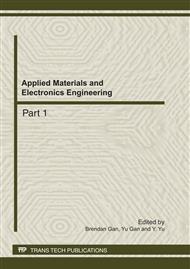[1]
Andreasen GF. and Hilleman TB., An evaluation of 55 cobalt substituted Nitinol wire for use in orthodontics. J Am Dent Assoc Vol. 82 (1997), pp.1373-5
DOI: 10.14219/jada.archive.1971.0209
Google Scholar
[2]
Brantley WA., Orthodontic wires. In:Brantly WA, Eliades T, editor. Orthodontic materials: scientific and clinical aspects. New York:Thieme (2000), pp.77-103
DOI: 10.1055/b-0034-43092
Google Scholar
[3]
Kusy RP., A review of contemporary archwires: their properties and characteristics., Angle Orthod Vol. 67 (1997), pp.197-207
Google Scholar
[4]
Rondelli G., Corrosion resistance test on NiTi shape memory alloys., Biomaterials, (1996), pp.2003-8
Google Scholar
[5]
Buehler WJ., Frederick FE., A summary of recent research on the nitinol alloys and their potential application in ocean engineering., Ocean Eng, (1968), pp.105-8
DOI: 10.1016/0029-8018(68)90019-x
Google Scholar
[6]
Shabalovskaya SA., On the nature of the bio compatibility and on medical applications of NiTi shape memory and superelastic alloys., Biomed Mater Eng, (1996), pp.267-89
DOI: 10.3233/bme-1996-6405
Google Scholar
[7]
Gil FJ, Planell JA. Effect of copper addition on the superelastic behaviour of NiTi shape memory alloys for orthodontic applications. J Biomed Mater Res Vol. 48 (1999), p.682–8
DOI: 10.1002/(sici)1097-4636(1999)48:5<682::aid-jbm12>3.0.co;2-m
Google Scholar
[8]
Gil FJ, Manero JM, Planell JA. Relevant aspects in the clinical applications of NiTi shape memory alloys. J Mater Sci: Mater Med Vol. 7 (1996), p.403–6
DOI: 10.1007/bf00122008
Google Scholar
[9]
Wever DJ, Veldhuizen AG, Sanders MM, Schakenrad JM, Horn v JR. The cytotoxic, allergic and genotoxic activity of a nickel – titanium alloy. Biomaterials Vol. 18 (1997), p.1115–20
DOI: 10.1016/s0142-9612(97)00041-0
Google Scholar
[10]
Ryh.anen J, Kallioinen M, Tuukkanen J, Lehenkari P, Junila J, Niemel.a E, Sanvik P, Serlo W. Bone modelling and cell–material interface response induced by nickel–titanium shape memory alloy after periosteal implantation. Biomaterials Vol. 20 (1999), p.1309–17
DOI: 10.1016/s0142-9612(99)00032-0
Google Scholar
[11]
Wever DJ, Veldhuizen AG, de Vries J, Busscher HJ, Uges DRA, van Horn JR. Electrochemical and surface characterization of a nickel–titanium alloy. Biomaterials Vol. 19 (1998), p.761–9
DOI: 10.1016/s0142-9612(97)00210-x
Google Scholar
[12]
Mohammed Es-Souni, et al., On the properties of two binary NiTi shape mempry alloys. Effects of surface finish on the corrosion behavior and in vitro biocompatibility, (2002), pp.2887-94
DOI: 10.1016/s0142-9612(01)00416-1
Google Scholar
[13]
Fathi MH, Salehi M, Saatchi A, Mortazavi V, Moosavi SB. In vitro corrosion behavior of bioceramic, metallic, and bioceramic-metallic coated stainless steel dental implants. Dental Mater Vol. 19 (2003), p.188–98
DOI: 10.1016/s0109-5641(02)00029-5
Google Scholar
[14]
Keun-Taek Oh, Young-Sik Kim, Yong-Soo Park, Kyoung-Nam Kim. Properties of Super Stainless steels for Orthodontic Applications. Interscience (2003), pp.183-194
Google Scholar
[15]
Oshida Y, Miyazali S. Corrosion and biocompatibility of shape memory alloys. Corros Eng Vol. 40 (1991), pp.1009-25
Google Scholar
[16]
Ryhanen J, Niemi E, Serlo W, Niemela E, Sandvik P, Pernu H, Salo T. Biocompatibility of nickel-titanium shape memory metal and its corrosion behavior in human cell cultures. J Biomed Mater Res Vol. 35 (1997), pp.451-7
DOI: 10.1002/(sici)1097-4636(19970615)35:4<451::aid-jbm5>3.0.co;2-g
Google Scholar
[17]
Wever DJ, Veldhuizen AG, Sanders MM, Schakenraad JM, Van Horn JR. Cytotoxic, allergic and genotoxic activity of a nickel-titanium alloy. Biomaterials Vol. 18 (1997), pp.1115-20
DOI: 10.1016/s0142-9612(97)00041-0
Google Scholar


